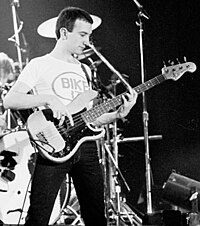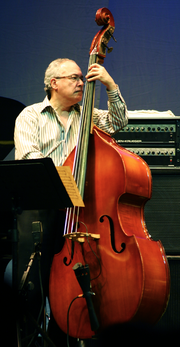Bassist

This article has multiple issues. Please help improve it or discuss these issues on the talk page. (Learn how and when to remove these messages)
|


A bassist (also known as a bass player or bass guitarist) is a musician who plays a bass instrument such as a double bass (upright bass, contrabass, wood bass), bass guitar (electric bass, acoustic bass), synthbass, keyboard bass or a low brass instrument such as a tuba or trombone. Different musical genres tend to be associated with one or more of these instruments. Since the 1960s, the electric bass has been the standard bass instrument for funk,[2] R&B, soul, rock, reggae, jazz fusion, heavy metal, country and pop. The double bass is the standard bass instrument for classical music, bluegrass, rockabilly, and most genres of jazz. Low brass instruments such as the tuba or sousaphone are the standard bass instrument in Dixieland and New Orleans-style jazz bands.
Despite the associations of different bass instruments with certain genres, there are exceptions. Some new rock bands and bassist used a double bass, such as Lee Rocker[3] of Stray Cats, Barenaked Ladies and Tiger Army. Larry Graham, Bernard Edwards, Mick Hogan, Andy Fraser, and Mel Schacher[4] used an electric bass guitar. Some funk, R&B and jazz, fusion groups use synth bass or keyboard bass rather than electric bass. Bootsy Collins, Stevie Wonder, Kashif and Kevin McCord(One Way) used synth bass. Some Dixieland bands use double bass or electric bass instead of a tuba. In some jazz groups and jam bands, the basslines are played by a Hammond organ player, who uses the bass pedal keyboard or the lower manual for the low notes. Keyboard driven bass also occurs occasionally in rock bands, such as the Doors and Atomic Rooster.
Electric bass players
[edit]





Electric bassists play the bass guitar. In most rock, pop, metal and country genres, the bass line outlines the harmony of the music being performed, while simultaneously indicating the rhythmic pulse. In addition, there are many different standard bass line types for different genres and types of song (e.g. blues ballad, fast swing, etc.). Bass lines often emphasize the root note, with a secondary role for the third, and fifth of each chord being used in a given song. In addition, pedal tones (repeated or sustained single notes), ostinatos, and bass riffs are also used as bass lines. While most electric bass players rarely play chords (three or more notes all sounded at the same time), chords are used in some styles, especially funk, R&B, soul music, jazz, Latin and heavy metal music.
Double bass players
[edit]Classical double bass players
[edit]See the List of contemporary classical double bass players.
Jazz double-bass players
[edit]
See the List of jazz bassists, which includes both double bass and electric bass players.
Popular music double bass players
[edit]See the List of double bassists in popular music, which includes blues, folk, country, etc.
See also
[edit]References
[edit]- ^ "Jaco Pastorius Is the Most Important Musician You Might Have Never Heard Of". vice.com. 6 March 2015. Archived from the original on 25 October 2015. Retrieved 17 October 2015.
- ^ "On Bass: What the Funk?". premierguitar.com. 11 February 2014. Archived from the original on 2 October 2016. Retrieved 27 September 2016.
- ^ "Double bassist Lee Rocker is still jamming and touring - AXS". Archived from the original on 16 October 2018. Retrieved 16 August 2019.
- ^ "Mel Schacher Bio". www.grandfunkrailroad.com. Archived from the original on 20 June 2019. Retrieved 22 October 2021.